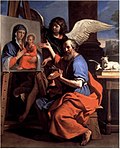Search results
Appearance
There is a page named "Federico Zuccari" on Wikipedia
- Federico Zuccaro, also known as Federico Zuccari and Federigo Zucchero (c. 1540/1541 – July/August 1609), was an Italian painter, draughtsman, architect...16 KB (1,964 words) - 07:28, 26 March 2025
- Renaissance master Giorgio Vasari in 1572 and completed after his death by Federico Zuccari, in 1579. Initially commissioned by Grand Duke Cosimo I de' Medici...20 KB (2,388 words) - 15:37, 7 March 2025
- Monti in the Campo Marzio neighborhood of Rome, Italy. Designed by Federico Zuccari, the house is known locally as the "House of Monsters" for the decorations...7 KB (787 words) - 20:42, 19 October 2024
- pre-eminent studio of the day, that of the Mannerist painters, Taddeo and Federico Zuccari. After passing four years at Rome, he returned to his native city,...20 KB (1,464 words) - 19:02, 24 February 2025
- Elders of Apocalypse was finished by Vasari before his death in 1574. Federico Zuccari with the assistance of Bartolomeo Carducci, Domenico Passignano and...69 KB (8,238 words) - 11:01, 3 April 2025
- his sons Taddeo Zuccari (1529-1566) and Federico Zuccari (c. 1540-1609); Anna Radius Zuccari (1846–1918), Italian writer Carlo Zuccari (1703-1792), Italian...611 bytes (116 words) - 01:33, 10 November 2024
- Scultori di Roma was approved by papal brief in 1577, and in 1593 Federico Zuccari became its first principe or director; the statutes were ratified in...15 KB (1,541 words) - 23:25, 19 March 2025
- Federico Zuccari, Two Painter's Apprentices, 1609. They would have to produce a masterpiece to become masters at the end of their apprenticeships....10 KB (942 words) - 13:50, 15 February 2025
- possible that he visited Venice and saw the works of Giorgione, whom Federico Zuccari later accused him of imitating, and Titian. He would also have become...101 KB (12,033 words) - 04:15, 10 March 2025
- Taddeo Zuccaro (or Zuccari) (1 September 1529 – 2 September 1566) was an Italian painter, one of the most popular members of the Roman mannerist school...6 KB (626 words) - 00:07, 7 March 2025
- painter Edward Zuccaro (1943–2025), American politician from Vermont Federico Zuccari (c. 1540-1609, Italian painter Ignazio Zuccaro (1839–1913), Italian...618 bytes (107 words) - 04:17, 11 February 2025
- where are found bronze sculptures, and canvases by Pellegrino Tibaldi, Federico Zuccari, and Leone Leoni. In the sacristy, paintings such as Joseph's Coat...53 KB (6,421 words) - 01:16, 7 February 2025
- ceiling paintings by Battista Franco, and murals and altarpiece by Federico Zuccari. The chapel has been restored by the British charity Venice in Peril...31 KB (3,390 words) - 23:36, 5 January 2025
- extension of the palace. Decorating the rooms were many artists including Federico Zuccari, architect of the monumental staircase, and Camillo Mantovano. The...16 KB (2,248 words) - 14:12, 2 April 2025
- decoration was carried out by a team of painters under Girolamo Muziano and Federico Zuccari. In 1566, the Cardinal made his fifth effort to be elected Pope, but...68 KB (10,184 words) - 13:42, 20 February 2025
- Palazzo Zuccari is a 16th-century palace in Florence built by Federico Zuccari. 43°46′39.13″N 11°15′47.28″E / 43.7775361°N 11.2631333°E / 43.7775361;...483 bytes (36 words) - 17:26, 6 June 2024
- Urbino (section Period of Federico da Montefeltro)Urbino, medieval condottiere and patron of the arts Federico Zuccari (c. 1540/1541–1609) and Taddeo Zuccari (1529–1566), Italian painters. They were born nearby...29 KB (3,431 words) - 10:07, 21 March 2025
- Muziano, Livio Agresti (a member of the "Forlì painting school") or Federico Zuccari. In 1527 Tivoli was sacked by bands of the supporters of the emperor...18 KB (1,966 words) - 22:53, 3 December 2024
- Lucrezia d'Este Portrait attributed to Federico Zuccari. Duchess consort of Urbino Lady consort of Pesaro Tenure 28 September 1574 – 12 February 1598 Born...13 KB (1,446 words) - 21:08, 25 May 2024
- frescoes, due to Cesare Nebbia, Federico Zuccari and aides, were made at the beginning of the 17th century on commission by Federico Borromeo; they cover the...23 KB (2,366 words) - 20:58, 13 August 2024
- sister projects: Wikipedia article, Wikidata item See also Taddeo Zuccari and Federico Zuccari on Wikipedia; and our 1911 Encyclopædia Britannica disclaimer


















